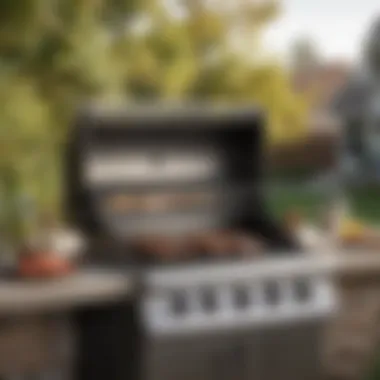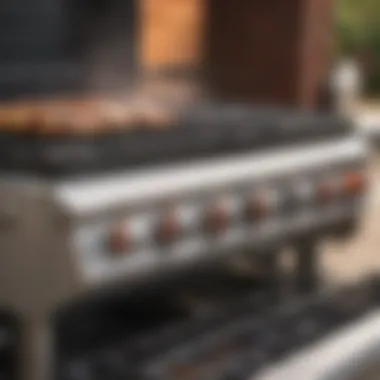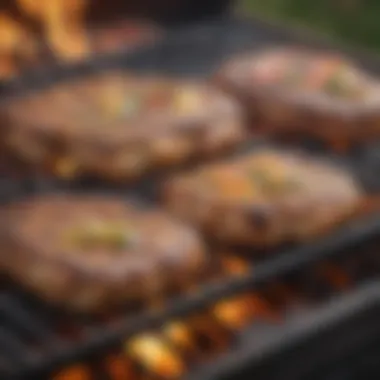Mastering the Propane Gas Grill with Side Burner


Intro
The popularity of propane gas grills with side burners has grown steadily among culinary enthusiasts. Such units not only offer convenience but also enhance the outdoor cooking experience. Understanding how to effectively use a propane gas grill with a side burner can translate into a more versatile cooking method. It allows grilling while simultaneously preparing sides or sauces. This comprehensive guide will navigate through several essential aspects, from selecting the right grill to maintaining it for years of enjoyable use.
Recipe Overview
For many, grilled dishes become synonymous with summer evenings. Below, we will create a recipe specifically designed for maximizing the efficiency and convenience of a propane grill paired with a side burner. Many of these qualities lead to delightful culinary rewards.
- Crispy BBQ Chicken Thighs with Grilled Vegetables
- Yields: 4 portions
- Prep time: 15 minutes
- Cook time: 30 minutes
- Difficulty: Medium
- Main Ingredients:
- Chicken thighs
- Olive oil
- BBQ sauce
- Bell peppers
- Zucchini
- Salt and pepper
Step-by-Step Instructions
- Prep the Ingredients:
- Preheat the Grill:
- Grill the Chicken:
- Cook the Vegetables:
- Start by washing and cutting the bell peppers and zucchini into bite-sized pieces.
- Pat chicken thighs dry with a paper towel before seasoning.
- In a bowl, mix olive oil, salt, and pepper. Coat the chicken lightly.
- Ensure the main grilling surface is preheated to medium-high.
- Prepare the side burner at low heat for the vegetables.
- Place chicken thighs skin-side down on the hot grill. Sear for about 5 to 7 minutes.
- Flip the chicken, brush with BBQ sauce, and close the grill lid. Cook for another 15 to 20 minutes or until the internal temperature reaches 165°F (75°C).
- Heat a pan on the side burner and add a little olive oil.
- Place the chopped vegetables in the pan. Season with salt and pepper.
- Cook until slightly charred and tender, about 10 minutes.
Time-saving Tip: To speed up your cooking process, marinate the chicken thighs the night before.
Nutritional Information
- Total calories per portion: 450
- Proteins: 28g
- Fats: 25g
- Carbohydrates: 15g
This dish is also packed with essential vitamins and minerals. Bell peppers provide Vitamin C, while zucchini offers antioxidants. Together, these elements help create a nutritionally balanced meal.
Quick Cooking Tips
- Utilizing Gadgets: Consider using a grill pan on the side burner if you like bringing your vegetables inside without losing char flavor.
- Multitasking: While the chicken cooks, keep an eye on the vegetables, stirring as needed.
- Healthy Alternatives: Swap BBQ sauce for a lighter version or use fresh herbs and spices to provide a bit of flavor without extra calories.
Related Recipes & Variations
After enjoying crispy BBQ chicken thighs, consider trying:
- Grilled salmon with lemon herb rice
- Vegetable skewers for a side dish
- Marinated tofu for a plant-based option
Feel free to get creative and share what variations you've successfuly made using your propane gas grill!


Outdoor grilling represents not just a method of cooking, but also an engaging experience that fosters creativity and enjoyment among food enthusiasts.
Intro to Propane Gas Grills
In the realm of outdoor cooking, the propane gas grill stands as a preferred choice for many culinary enthusiast. The appeal of this cooking device can be attributed to a number of important elements. First, the convenience that propane offers cannot be overstated. With easy ignition and adjustable heat settings, users can achieve desired cooking results with minimal effort.
Another significant consideration is the efficiency of propane gas. In many cases, a propane bottle can sustain several grilling sessions, generally more than charcoal or electric options. This fuel efficiency is particularly valuable for those who frequently host gatherings or enjoy cooking outdoors. The ability to reach high temperatures swiftly also enhances the cooking experience.
From a flavor standpoint, propane gas grills deliver results that many find attractive. While some purists may argue that charcoal infuses a deeper taste, skilled users of propane grills can still produce delicious and smoky flavors. Additionally, roasting meats and adding a smoke box can enhance complexity in flavors.
Grills with side burners also add features that elevate the versatility of cooking outdoors. Meaning that home chefs can utilize additional cooking spaces, expanding their capabilities and options as they prepare meals.
In this section, we explore the foundational aspects of propane gas grills, underscoring their importance in the context of culinary practices. Emphasizing their considerations not only enables informed decisions when purchasing but also cultivates a richer cooking experience. The evolution of grilling culture makes it essential for modern cooks to understand these core elements. Be it a novice or seasoned griller, knowledge around propane gas grills is pivotal for optimum outdoor cooking.
The Advantages of Using Propane Gas
In the realm of outdoor cooking, propane gas emerges as a dominant choice for grills, renowned for its advantages. Understanding these benefits can be essential for anyone considering elevating their culinary experience. The specific characteristics of propane contribute to both efficiency in cooking and convenience in operation, appealing greatly to busy cooking enthusiasts.
Efficiency and Convenience
Propane gas shines in its efficiency compared to other fuel sources, like charcoal or electric grills. It ignites quickly, reduces waiting time, and enables instant control of heat levels. This speed can be a game-changer while preparing meals. Forgoing the tedious setup involved with charcoal means more time focusing on the cooking itself. Many users appreciated how easy it is to preheat a propane grill. Just a minute of igniting the flames and adjusting the knobs grants you a solid and controllable temperature for grilling.
Another significant advantage is its portability. Propane tanks are easy to transport, making grills quite versatile. Whether one operates at home, on a camping expedition, or tuned into tailgate parties, propane blends seamlessly into various situations. It sits alongside modern lifestyles that often demand integration of quick, efficient cooking methods.
Propane offers chefs the chance to experiment and engage in culinary adventures, eliminating the hassle often associated with traditional grilling methods.
Flavor Considerations
While many prioritize efficiency in their choice of fuel the flavor imparted during grilling cannot be disregarded. Propane fuel influences how recipes manifest when cooking. There is an ongoing debate regarding the Q gas' flavor profile versus wood, charcoal, or other fuels. For many cooks, propane doesn't overshadow the natural flavors of ingredients. On the contrary, it can enhance them — from the searing process of meats to gradual roasting of vegetables.
Additionally, propane grilling allows for precise control over temperature. Such precision proves beneficial in culinary preparation, especially for delicate items like fish or vegetables. Cooks can rest assured knowing that they aren’t introducing unwanted flavors into their meal by burning chard or overcooking. The high grilling temperature fed by propane helps lift many recipes to an upscale restaurant level.
By efficiently balancing convenience and enhancing taste, using propane gas as a fuel source fills the needs of adept culinary enthusiasts while keeping interactions at the grill pleasurable and engaging.
What is a Side Burner?
Understanding what a side burner is crucial when assessing a propane gas grill's functionality. The side burner enhances cooking versatility, allowing users to prepare multiple dishes concurrently. This feature simplifies the cooking process, making it more efficient and enjoyable, especially during gatherings. The presence of a side burner can differentiate a grill from standard models, adding value and utility.
Definition and Functionality
A side burner is an additional cooking area found on some propane gas grills. It operates independently of the main grill, providing extra space for cooks to prepare various items. The side burner usually emits direct heat, similar to a stovetop burner, making it compatible with cookware and enabling a multitude of cooking techniques. This functionality ensures that cooks can sauté, boil, or simmer while grilling meats and vegetables simultaneously. For chefs looking to maximize output, a side burner serves as a highly valuable asset.
Common Uses of a Side Burner


Heating sauces
Heating sauces on a side burner offers substantial advantages. This method allows for simmering sauces without requiring additional countertop space or appliances. By keeping the sauce warm while the main grilling process occurs, flavors can enhance, improving overall dish quality. Careful temperature control is feasible, ensuring that sauces do not overcook or burn while maintaining moisture and flavor integrity.
Sautéing vegetables
Sautéing vegetables on a side burner allows for rapid cooking, preserving texture and nutrition. This method grants flexibility in preparing healthy side dishes while the main courses are on the grill. Quick cooking times mean that vegetables can retain their natural crispness, balancing each meal. Furthermore, this technique facilitates the integration of various flavors, boosting overall meal harmony.
Cooking side dishes
The ability to cook side dishes on a side burner is an essential aspect of meal preparation. From boiling potatoes to making rice or grains, this functionality ensures comprehensive meals are feasible during outdoor cooking. Cooks can prepare classic side accompaniments alongside main grill items like steaks or chicken, contributing to a complete dining experience. Utilizing a side burner also reduces the need to run back to the kitchen, maintaining the outdoor cooking atmosphere.
"A side burner allows for efficient meal preparation, enriching the grilling experience with diverse cooking methods."
Overall, a side burner significantly enhances cooking possibilities on a propane gas grill. Preparing sauces, sautéing vegetables, and cooking side dishes increase convenience and reduce time necessity. Their importance in culinary setups cannot be overstated, as they maximize outdoor cooking potential evidently.
Key Features to Look for in a Propane Gas Grill
When selecting a propane gas grill, a few key features significantly impact your grilling experience. Understanding these features will guide culinary enthusiasts toward making informed decisions that align with their cooking style and needs. A well-chosen grill serves not just as a cooking appliance but as an investment in your outdoor culinary endeavors.
BTU Output and Performance
British Thermal Units, or BTUs, measure the grill's heat output. This figure influences cooking speed and temperature control. A higher BTU rating usually suggests faster searing and more robust cooking performance. However, simply having a high BTU number isn’t everything. It's critical to strike a balance between output and grill size. Ideally, look for grills providing adequate heat while maintaining efficient energy use. This optimization leads to tastier food without excessive gas consumption.
Construction Material
Choosing the right material for the grill translates into durability and ease of use. Two of the most prevalent materials used in propane grills are stainless steel and porcelain-coated surfaces. Understanding these can help buyers make strategic choices.
Stainless Steel
Stainless steel marks the hallmark of grill construction. The major benefit is its resistance to rust and weather-related wear. If paired with thoughtful care, a stainless steel grill can bolster longevity significantly. One of its distinctive features is its sleek appearance that appeals to modern households. However, it may heat up faster than other materials, thus requiring more vigilance to avoid inconsistencies in temperature. Practicing proper heat management can thwart undesirable flare-ups.
Porcelain-coated surfaces
Porcelain-coated grills offer a different attractive option. They boast a non-stick quality that facilitates cooking and enhances flavors. The coating protects the grill from rust, making it an excellent choice for those living in humid areas. However, one should be cautious; rough cleaning practices can chip away the ceramic layer. If chipped, the grill’s efficiency diminishes. Therefore, always opt for soft-bristle brushes when maintaining porcelain-coated surfaces. The right renovation care results in fewer replaceable components, reinforcing cost-effectiveness over the grill’s lifetime.
Grill Area and Side Burner Size
Equally crucial is the grill area size. A spacious grilling surface allows simultaneous cooking of multiple items, enhancing time management during meal preparation. When entertaining larger groups, consider grills equipped with ample real estate on the cooking surface. Side burner size also matters and offers numerous advantages. Side burners permit culinary experimentation; thus, your propane grill becomes ast versatile tool for sizzling sides and delicious sauces. Here’s where flexibility can elevate your grilling game, merging the main body of the grill with extra burners.
Selecting the right grill encompasses all these elements. Proper research allows you to tailor your choice to your lifestyle, ensuring an enriching cooking experience. The blend of performance, structural components, and usability factors leads to a fulfilling engagement with outdoor cooking.
Considerations for Safe Operation


Operating a propane gas grill with a side burner requires mindfulness about safety. Both for enjoyment and avoiding hazardous situations, understanding safety elements is crucial. Dealing with flammable gas brings inherent risks, thus adhering to proper safety practices is essential. This ensures not only a successful cooking experience but also the safety of yourself, loved ones, and your property.
Proper Ventilation
Good ventilation is critical when using a propane gas grill. It minimizes the risk of gas accumulation, which can lead to dangerous conditions. Grilling should ideally occur in an open area where air can flow freely. Avoid places such as enclosed porches or garages. Here are some valuable points to consider regarding ventilation:
- Open Area: Ensure your grill is placed outdoors, not in confined spaces. The open air allows for safe dispersal of any gas that may escape.
- Distance from Buildings: Position the grill at least ten feet away from structures. This practice helps prevent heat damage to nearby walls or windows.
- Avoid Wind Blocks: Grilling in a spot shielded from the wind helps maintain flame levels but too much cover may block necessary airflow. Find a balance that allows air circulation.
Following these guidelines can significantly improve your grilling experience while reducing risks.
Gas Leak Prevention
Gas leaks are a serious concern that warrants careful attention. Taking proactive steps is vital for ensuring operating safety. Regular checks and maintenance significantly reduce the possibility of such hazards. Here are pragmatic measures to prevent gas leaks:
- Inspection of Hoses: Regularly check the propane hoses for any signs of wear, fraying, or cracks. Even small imperfections can become larger issues leadimg to leaks.
- Soap Solution Test: Mix a solution of soap and water to create a bubble test. Apply this solution to the connections while the gas is on. Look for bubbling, which indicates leakage. If found, do not ignore this; disconnect and rectify the issue before proceeding.
- Proper Shut-Off Practices: After each use, always turn off the propane cylinder first, followed by the burners. This order reduces residual gas left in the system.
- Avoid Overfilling: When refilling tanks, ensure it is filled only to the proper levels, avoiding overmaxing limits. Overfilling poses extra risks for leaks.
Remember: Safety does not end with initial setup. Make it a habit to inspect and maintain your grill regularly. A shockingly high number of grill-related incidents are due to preventable leaks.
In summary, understanding key safety considerations when operating a propane gas grill ensures not just efficiency but prioritizes the health of those grilling as well. Implementing diligent ventilation strategies and gas leak prevention measures can solidify a safe and enjoyable outdoor experience.
Maintaining Your Propane Gas Grill
Maintaining your propane gas grill is essential for ensuring optimum performance. Proper maintenance enhances the grill’s longevity, promotes safety during operation, and improves the quality of your cooked food. Furthermore, by regularly cleaning and inspecting your grill, you can enjoy a hassle-free and enjoyable grilling experience.
Regular Cleaning Practices
Regular cleaning is critical to successful grilling. Crumbs and residue can accumulate over time, leading to flare-ups or unwanted contamination on your food. Follow these basic steps for effective cleaning:
- Clean the grates: After each use, scrape the grates with a grill brush. It will remove stuck-on food particles, aiding in better heat circulation next time you cook.
- Burner assembly: Periodically inspect the burner assembly for blockages. A clean burner ensures even cooking and prevents gas from leaking.
- Grease traps: Empty grease traps regularly. This simple task not only prevents fire hazards but also enhances the flavor of foods by preventing old grease from ruining your meals.
Be diligent in your practices to maximize the performance of your grill.
Inspections for Longevity
To further extend your grill’s lifespan, regular inspections are essential. Make sure to check two specific areas:
Checking for rust
Rust can significantly impact the functionality and safety of your grill. It is important to identify any rust activity early. Those areas tend to weaken material and can lead to dangerous failures during operation.
- Key characteristic: Inspect all grilling surfaces, especially those in contact with fats, oils, and moisture. A small rust spot may indicate deeper corrosion.
- Benefits: Recognizing and removing rust early can prevent far drift into the other parts of your grill, preserving its integrity.
- Unique feature: Anti-rust treatments are available. These coatings provide an added layer of protection against moisture build-up.
Burner condition
The burner condition has a direct effect on the efficiency of your grill. Regular checks should be performed to identify any signs of blockage or damage.
- Key characteristic: Ensure any holes or outlets on your burners remain clear. Cleaning tips often involve using a pin or cloth for debris removal.
- Benefits: A properly functioning burner guarantees an even distribution of heat.
- Unique feature: Some products can restore burner performance if your burners are compromised but not entirely beyond repair.
Follow these inspections to maintain an efficient grille.







